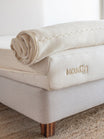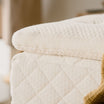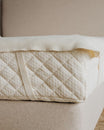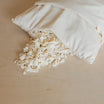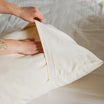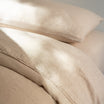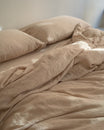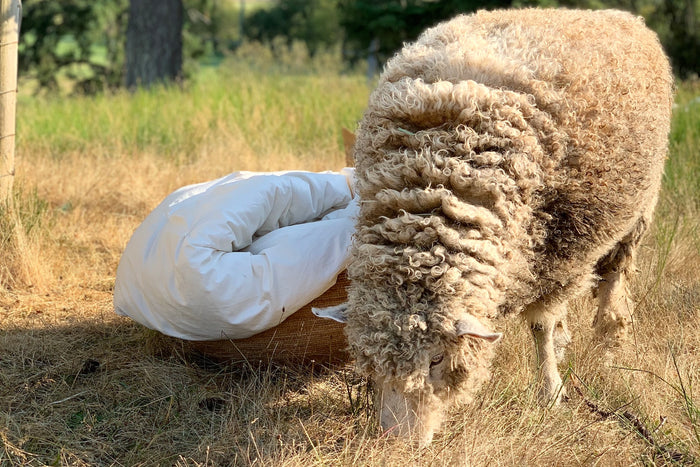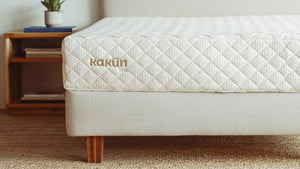When someone mentions bedding, which materials come to mind? Depending on where you are in the world, you might think of cotton, down, or synthetic fibres. Perhaps you envision more historical sleep solutions like rope or reeds. Or maybe that math textbook from junior high school encouraged the best naps ever. But what about wool?
Often overlooked in discussions of bedding, it turns out that wool is quite the ideal material for a good night’s rest. No longer relegated to slumpy socks, scratchy blankets, and stodgy military uniforms, modern bedding designers have carefully studied wool’s unique properties and applied them to comforters, mattresses, pillows, blankets, mattress pads, and more, so you get the best sleep possible.
Each item in your sleep suite that features wool takes advantage of thousands of years of evolution. Which is to say, sheep sleep great for a reason. Let’s take a look at the remarkably evolved composition of wool and how it can help you get your best rest.
The Composition of Wool
Through natural, Darwin-style evolution followed by thousands of years of selective breeding by humans, sheep raised for wool today produce a fibre that is absolutely ideal for bedding. Sheep look fluffy and that seems comfortable for sleeping, right? It’s not so simple. While fluffiness is certainly part of the equation, there are things happening in wool on a microscopic level that bring so much more to the table (or bed, as it were).
The Coil
Sheep evolved wool to protect them from life outside in the elements: from blistering desert heat to frigid nighttime temperatures, sheep are equipped to deal with it. And a lot of that stoicism in the face of climate extremes comes from the structure of wool. Made from multiple layers of proteins including keratin (the same protein as in your own hair and fingernails) with a helical coiled core, wool benefits from a built-in crimp. Stretch the crimp out and it springs back to its original shape, which means that wool maintains a natural loft that traps small pockets of air throughout. These pockets insulate the sheep, or you under a comforter, from rapid changes in temperature, ensuring that you stay thermally regulated throughout the night. No sweating, no chills.
In addition to temperature regulation, the interior structure of wool also makes it extremely resilient. The natural crimp helps wool stretch and return to its original shape; this article from PBS states that wool, “can bend back on itself 20,000 times without breaking. Compare this to cotton at 3,200 times, silk at 1,800, and rayon at only 75 times.” That’s a lot of bending.
The Scale
Though wool may appear smooth and uniform to the naked eye, put it under a microscope and you’ll find that the surface of each fibre is actually scaled like a comfy, sleepy fish. And while we can’t feel the scales against our skin, we can benefit from them. These scales actually make wool less susceptible to dirt and damage and enable it to felt, which is important for things like wool mattress pads, which need to be moisture resistant but still soft and comfortable.
The Matrix and the Membrane
We’ve all woken up in a cold sweat after one too many late night slices of pizza by the light of the refrigerator. Unless, that is, you sleep wrapped in wool bedding.
We produce a lot of moisture while we sleep: sweat, humidity in our breath, even damp air in our bedrooms can lead to clammy, sticky nights. But two facets of wool’s structure work together to allow the fibres to regulate humidity while you sleep. The membrane, which is the outside part of filaments that run through the wool fibre, absorbs humidity from the air. Deeper inside the fibre is the matrix, which contains sulphurous proteins that allow wool to absorb up to 30% of its own weight in moisture and humidity. The matrix is also the portion of the fibre that makes wool fire and static resistant, which is one reason why wool is so often found in clothing meant for dangerous situations—particularly military and firefighting uses.
Working Together
The matrix, membrane, and helical coil all work together to produce one of the most desirable qualities of wool—breathability. As you sleep, you produce both heat and moisture. Under a synthetic or tightly woven comforter, and with insulating down-filled duvets, that heat and moisture are trapped, leading to alternating bouts of sweating and shivering all night long. Wool, on the other hand, because of the moisture absorbing and natural loft properties, allows your body heat to be maintained without building up, while the matrix and membrane allow moisture to diffuse through the wool fibres and air pockets until it can evaporate (i.e. moisture wicking). This is referred to as breathability and it’s a true game-changer when it comes to getting a good night’s rest, since you never end up too hot, too cold, or too damp.
Lanolin
Last but far from least is lanolin. A waxy substance produced by sheep to keep their wool soft and supple, lanolin is mostly stripped from industrially produced wool, like that used for clothing. However, Resthouse wool products retain a percentage of natural lanolin for an amazing effect: lanolin is antimicrobial. So while your standard bedding is amassing significant bacterial and fungal loads the longer it has been since wash day, your wool bedding is actively preventing those microscopic stinkers from fouling your perfect sleep environment.
Zooming Out
At the microscopic level, sheep have evolved to provide a truly incredible fibre for bedding. Wool is breathable, temperature regulating, and durable. It controls moisture, is fire and static resistant, and amazingly, antimicrobial. The science of wool is truly incredible. But if we put the microscope away and bring our point of view back to a human scale, what do we see in front of us? Beautiful bedding that smells fresh, feels wonderful against your skin, helps you sleep your best, and lasts a lifetime.



